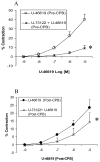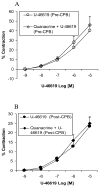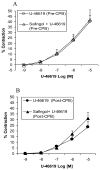Impaired contractile response of human peripheral arterioles to thromboxane A-2 after cardiopulmonary bypass
- PMID: 21801963
- PMCID: PMC3148492
- DOI: 10.1016/j.surg.2011.06.004
Impaired contractile response of human peripheral arterioles to thromboxane A-2 after cardiopulmonary bypass
Abstract
Background: We studied the contractile response of human peripheral microvasculature to thromboxane A-2 (TXA-2) before and after cardiopulmonary bypass (CPB), with and without the blockade of TXA-2 receptors, or the inhibition of phospholipase C (PLC), phospholipase A-2 (PLA-2) or protein kinase C (PKC)-α. We also examined the protein/gene expression and localization of TXA-2 receptors, TXA-2 synthase, PLC, and other TXA-2-related proteins.
Methods: Skeletal muscle arterioles (90-180 μm in diameter) were harvested pre- and post-CPB from patients (n = 28) undergoing cardiac surgery.
Results: The post-CPB contractile response of skeletal muscle arterioles to TXA-2 analog U-46619 was impaired compared with pre-CPB (P < .05). The presence of TXA-2 receptor antagonist SQ-29548 (10(-6)mol/L) prevented the contractile response to U-46619 (P < .05). Pretreatment with the PLC inhibitor U-73122 (10(-6)mol/L) significantly inhibited the U-46619-induced contractile response (P < .01). Administration of the PLA-2 inhibitor quinacrine (10(-6)mol/L) or PKC-α inhibitor safingol (2 × 10(-5)mol/L), however, failed to affect U-46619-induced contraction. Total protein levels and gene expression of TXA-2 receptors, and TXA-2 synthase of skeletal muscle, were not altered post-CPB. Confocal microscopy showed no differences in the expression of PLCβ-3 in the microcirculation. PLCβ-3 was localized to both smooth muscle and endothelium.
Conclusion: CPB decreases the contractile response of human peripheral arterioles to TXA-2 soon after cardiac surgery. This response may be in part responsible for the decrease in vascular tone, and accompanying hypotension sometimes observed after cardiac operations utilizing CPB.
Copyright © 2011 Mosby, Inc. All rights reserved.
Figures







Similar articles
-
Decreased contractile response of peripheral arterioles to serotonin after CPB in patients with diabetes.Surgery. 2018 Aug;164(2):288-293. doi: 10.1016/j.surg.2018.03.007. Surgery. 2018. PMID: 29759300 Free PMC article.
-
Thromboxane-induced contractile response of human coronary arterioles is diminished after cardioplegic arrest.Ann Thorac Surg. 2011 Sep;92(3):829-36. doi: 10.1016/j.athoracsur.2011.04.049. Ann Thorac Surg. 2011. PMID: 21871266 Free PMC article.
-
Effects of cardiopulmonary bypass on endothelin-1-induced contraction and signaling in human skeletal muscle microcirculation.Circulation. 2010 Sep 14;122(11 Suppl):S150-5. doi: 10.1161/CIRCULATIONAHA.109.928226. Circulation. 2010. PMID: 20837906 Free PMC article.
-
Enhanced coronary arteriolar contraction to vasopressin in patients with diabetes after cardiac surgery.J Thorac Cardiovasc Surg. 2018 Dec;156(6):2098-2107. doi: 10.1016/j.jtcvs.2018.05.090. Epub 2018 Jun 8. J Thorac Cardiovasc Surg. 2018. PMID: 30057184 Free PMC article.
-
Endothelin-1-induced contractile responses of human coronary arterioles via endothelin-A receptors and PKC-alpha signaling pathways.Surgery. 2010 Jun;147(6):798-804. doi: 10.1016/j.surg.2009.11.016. Epub 2010 Jan 15. Surgery. 2010. PMID: 20079914 Free PMC article.
Cited by
-
Decreased coronary arteriolar response to KCa channel opener after cardioplegic arrest in diabetic patients.Mol Cell Biochem. 2018 Aug;445(1-2):187-194. doi: 10.1007/s11010-017-3264-x. Epub 2018 Jan 5. Mol Cell Biochem. 2018. PMID: 29305679 Free PMC article.
-
Skeletal muscle microvasculature response to β-adrenergic stimuli is diminished with cardiac surgery.Surgery. 2020 Feb;167(2):493-498. doi: 10.1016/j.surg.2019.07.018. Epub 2019 Sep 4. Surgery. 2020. PMID: 31493902 Free PMC article.
-
Impaired coronary contraction to phenylephrine after cardioplegic arrest in diabetic patients.J Surg Res. 2018 Oct;230:80-86. doi: 10.1016/j.jss.2018.04.045. Epub 2018 May 22. J Surg Res. 2018. PMID: 30100044 Free PMC article.
-
Decreased contractile response of peripheral arterioles to serotonin after CPB in patients with diabetes.Surgery. 2018 Aug;164(2):288-293. doi: 10.1016/j.surg.2018.03.007. Surgery. 2018. PMID: 29759300 Free PMC article.
-
Microvascular dysfunction following cardiopulmonary bypass plays a central role in postoperative organ dysfunction.Front Med (Lausanne). 2023 Feb 14;10:1110532. doi: 10.3389/fmed.2023.1110532. eCollection 2023. Front Med (Lausanne). 2023. PMID: 36865056 Free PMC article. Review.
References
-
- Ruel M, Khan TA, Voisine P, Bianchi C, Sellke FW. Vasomotor dysfunction after cardiac surgery. Eur J Cardiothorac Surg. 2004;26:1002–14. - PubMed
-
- Khan TA, Bianchi C, Araujo EG, Ruel M, Voisine P, Li J, Liddicoat JR, Sellke FW. Cardiopulmonary bypass reduces peripheral microvascular contractile function by inhibition of mitogen-activated protein kinase activity. Surgery. 2003;134:247–54. - PubMed
-
- Metias C, Li J, Simons M, Sellke FW. Serotonin-induced coronary contraction increases after blood cardioplegia-reperfusion: role of COX-2 expression. Circulation. 1999;100(Suppl II):II328–34. - PubMed
-
- Sodha NR, Feng J, Clements RT, Bianchi C, Boodhwani M, Ramlawi R, Mieno S, Sellke FW. Protein Kinase Calpha modulates microvascular reactivity in the human coronary and skeletal microcirculation. Surgery. 2007;142:243–52. - PubMed
Publication types
MeSH terms
Substances
Grants and funding
LinkOut - more resources
Full Text Sources

